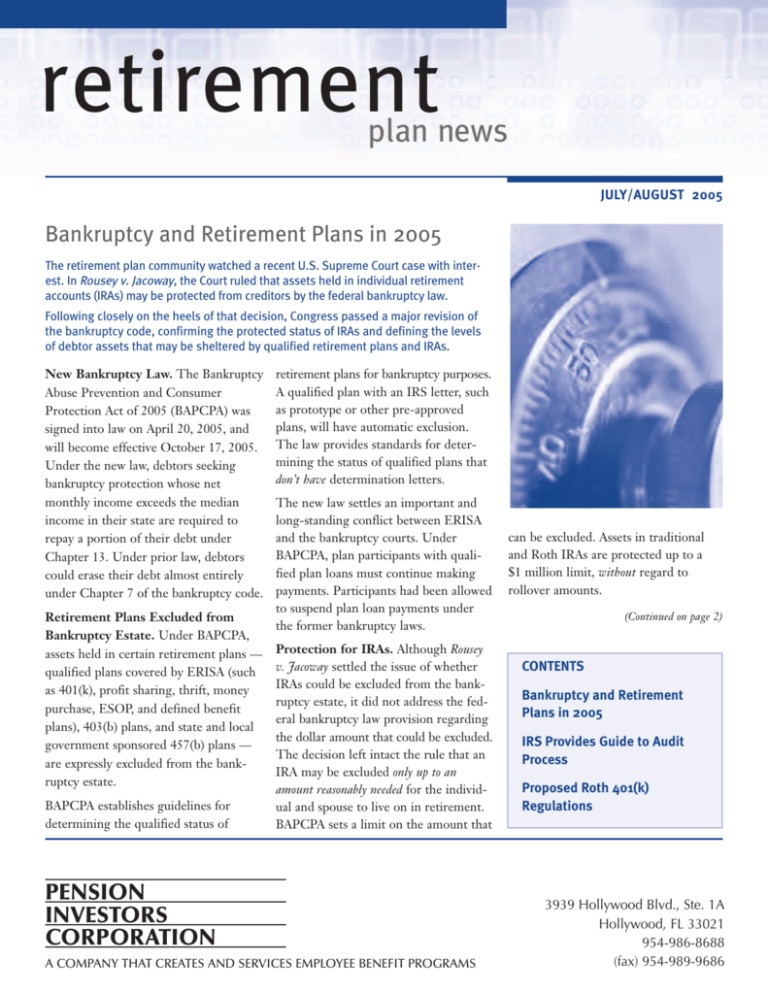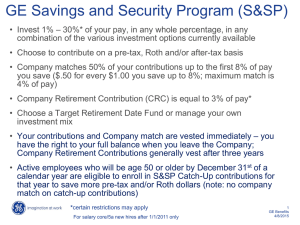July - August - Pension Investors Corporation
advertisement

retirement plan news JULY/AUGUST 2005 Bankruptcy and Retirement Plans in 2005 The retirement plan community watched a recent U.S. Supreme Court case with interest. In Rousey v. Jacoway, the Court ruled that assets held in individual retirement accounts (IRAs) may be protected from creditors by the federal bankruptcy law. Following closely on the heels of that decision, Congress passed a major revision of the bankruptcy code, confirming the protected status of IRAs and defining the levels of debtor assets that may be sheltered by qualified retirement plans and IRAs. New Bankruptcy Law. The Bankruptcy Abuse Prevention and Consumer Protection Act of 2005 (BAPCPA) was signed into law on April 20, 2005, and will become effective October 17, 2005. Under the new law, debtors seeking bankruptcy protection whose net monthly income exceeds the median income in their state are required to repay a portion of their debt under Chapter 13. Under prior law, debtors could erase their debt almost entirely under Chapter 7 of the bankruptcy code. Retirement Plans Excluded from Bankruptcy Estate. Under BAPCPA, assets held in certain retirement plans — qualified plans covered by ERISA (such as 401(k), profit sharing, thrift, money purchase, ESOP, and defined benefit plans), 403(b) plans, and state and local government sponsored 457(b) plans — are expressly excluded from the bankruptcy estate. BAPCPA establishes guidelines for determining the qualified status of retirement plans for bankruptcy purposes. A qualified plan with an IRS letter, such as prototype or other pre-approved plans, will have automatic exclusion. The law provides standards for determining the status of qualified plans that don’t have determination letters. The new law settles an important and long-standing conflict between ERISA and the bankruptcy courts. Under BAPCPA, plan participants with qualified plan loans must continue making payments. Participants had been allowed to suspend plan loan payments under the former bankruptcy laws. Protection for IRAs. Although Rousey v. Jacoway settled the issue of whether IRAs could be excluded from the bankruptcy estate, it did not address the federal bankruptcy law provision regarding the dollar amount that could be excluded. The decision left intact the rule that an IRA may be excluded only up to an amount reasonably needed for the individual and spouse to live on in retirement. BAPCPA sets a limit on the amount that PENSION INVESTORS CORPORATION A COMPANY THAT CREATES AND SERVICES EMPLOYEE BENEFIT PROGRAMS can be excluded. Assets in traditional and Roth IRAs are protected up to a $1 million limit, without regard to rollover amounts. (Continued on page 2) CONTENTS Bankruptcy and Retirement Plans in 2005 IRS Provides Guide to Audit Process Proposed Roth 401(k) Regulations 3939 Hollywood Blvd., Ste. 1A Hollywood, FL 33021 954-986-8688 (fax) 954-989-9686 Bankruptcy and Retirement Plans in 2005 (Continued from page 1) favored status, there may once again be good reason for participants to keep rollovers from retirement plans in separate IRAs and not commingle the funds with their personal IRAs. Considering that the maximum annual contribution amount for IRAs has been between $1,500 and the current limit of $4,000, the $1,000,000 limit set by BAPCPA for IRA assets will likely provide sufficient protection for these personal accounts for the foreseeable future. NOTE: Under BAPCPA, funds that are rolled over to an IRA from one of the qualified retirement plans mentioned above are excluded entirely from the bankruptcy estate. Because of this State Law versus Federal Law. State insolvency laws will still play a role in bankruptcies. Most states require that debtors claim their state’s exemptions first plus any additional exemptions provided under federal laws (such as ERISA). Some states, however, permit debtors to choose between exemptions provided under state laws and those provided under federal laws. In such instances, if state law protects IRA assets in excess of $1 million, an individual may choose to apply the state bankruptcy provision. (This is a decision that should be made with the advice of legal counsel.) Protection If Not in Bankruptcy. The laws regarding protection from creditors when an individual has not declared bankruptcy are unchanged. Assets in qualified plans covered by Title 1 of ERISA continue to be protected from creditors. Assets in IRAs and qualified plans not subject to Title 1 (such as sole proprietor plans without any “commonlaw employees”) are protected according to state laws. IRS Provides Guide to Audit Process plan audit and provide information about how issues identified during an examination will be handled. The IRS Employee Plans (EP) division has developed new materials to help retirement plan sponsors and practitioners better understand the audit process. The EP Examination Process Guide has been developed as a comprehensive online resource to provide information about every phase of the plan examination process. A link to the Guide can be found at www.irs.gov/retirement/index.html. Here are some of the changes. 쐍 An Employee Plans Examination Bookmark has been added to provide a concise explanation of the rights of the employer sponsoring the plan and a summary of the advantages and responsibilities of maintaining a retirement plan. 쐍 Publication 1, Your Rights as a Taxpayer, has been replaced by Publication 1-EP, Understanding the Employee Plans Examination Process. IRS auditors are currently using these documents. 쐍 Letter 1346, which sets the audit appointment, has been made more “user friendly.” In an attempt to address the number one question raised by customers — “Why was I selected for examination?” — the revised letter explains why certain returns are selected for examination. 쐍 Lists have been developed for the various retirement plans outlining what information is needed for the examination (organized by tax code section) and why. 쐍 An Employee Plans Examination Process Flowchart has been created to illustrate the steps involved in a retirement 2 쐍 A “status update” letter has been developed to provide the employer and its representative with additional information when there are processing delays. Proposed Roth 401(k) Regulations When the Economic Growth and Tax Relief Reconciliation Act was passed in 2001, it added Section 402A to the Internal Revenue Code. Section 402A allows 401(k) plans and 403(b) arrangements to offer an after-tax, Roth-type contribution option. On March 2, 2005, the IRS issued proposed regulations that pave the way for eligible retirement plans to offer Roth contributions in plan years beginning on or after January 1, 2006. Although the final regulations may change (a public comment period was held through May 31 of this year), most proposed regulations are finalized as initially presented. or contributions, if a participant has made both Roth and pretax elective deferrals, he or she will have the option of designating which amounts are returned. Following is a summary of the current proposals. Once in the plan, Roth contributions are treated much the same as other elective deferrals. That includes distributions, which are prohibited before the participant reaches age 59½ except in the case of death, disability, hardship, or severance from service. The Overview. Amounts designated as Roth contributions are defined as elective contributions under a cash or deferred arrangement (CODA) that are: 쐍 Irrevocably designated as Roth contributions, 쐍 Wages that are subject to applicable withholding requirements at the time of deferral, and 쐍 Maintained in a separate account within the plan. Separate Account Rules. Roth-designated contributions must be kept in a separate account to ensure that the rules governing the proper tax treatment of contributions and distributions are followed. Generally, if Roth contributions remain in the plan for at least five years and are not withdrawn before age 59½, distribution of the earnings will not be taxable to the recipient (including the participant’s heirs). The separate treatment of Roth contributions must be maintained until the entire Roth account is distributed. Gains, losses, and other credits or charges must be separately allocated on a reasonable and consistent basis to the designated Roth contribution accounts as well as all the other accounts in the retirement plan. Plan forfeitures may not be allocated to Roth contribution accounts. Contribution Rules. If a Roth contribution option is available, participants will be able to designate some or all of their deferrals as Roth contributions. In the case of excess deferrals Unlike their Roth IRA “cousins,” Roth 401(k) contributions are subject to the required minimum distribution rules. Roth contributions are also subject to the actual deferral percentage (ADP) test, unless the plan elects the 401(k) safe harbor. And Roth-designated contributions are nonforfeitable. Going Forward. Before Roth contributions can occur, plan documents will have to be amended and participants provided with either a Summary Plan Description (SPD) or Summary of Material Modifications (SMM) describing the applicable rules. The IRS is expected to publish final regulations and model document language later this year. There is one major concern that remains at this point and that is the need for IRS guidance on the taxability of early distributions (before age 59½, for example) of Roth-designated amounts. Roth 401(k) provisions may be added to existing and new 401(k) plan documents after December 31, 2005, for the 2006 and later plan years. 3 recent developments DOL Updates Compliance Program. The Voluntary Fiduciary Correction (VFC) program (which falls under the Department of Labor) allows employers to voluntarily correct certain violations of ERISA’s rules governing fiduciary responsibility. The program requires plan sponsors to fully correct the violation, restore any losses or profits to the plan with interest, and distribute supplemental benefits, if any are owed, to eligible participants and beneficiaries. An expanded and simplified VFC program was proposed (April 6, 2005, Federal Register) that provides corrections for some additional fiduciary violations: delinquent participant loan repayments, illiquid plan assets sold to interested parties, and participant loans that violate certain plan restrictions. The guidance provides simpler methods of calculating earnings, an online calculator to determine asset restoration amounts, streamlined documentation, simplified eligibility requirements, and a model application form. The updated program can be used immediately. Life Insurance in Retirement Plans. The IRS has issued Revenue Procedure 2005-25 to provide guidance on how to calculate a fair market value for life insurance contracts, retirement income contracts, endowment contracts, or other life insurance products held in a retirement plan. The guidance addresses issues raised after a previous Revenue Procedure (2004-16) advocated valuation methods that did not work well for certain types of traditional insurance policies. According to the new guidance, a policy’s fair market value (FMV) for a qualified plan is determined as of the date of sale or distribution. Two safe harbor formulas for determining FMV are provided, one for non-variable contracts and one for variable contracts. As of May 1, 2005, Rev. Proc. 2005-25 is to be used for all valuations. Exception for 10% Early Distribution Penalty. The final 401(k) regulations clarified that a hardship distribution for medical expenses is based on the entire unreimbursed amount and not just the amount that exceeds 7.5% of adjusted gross income (AGI). Thus, all Section 213 medical expenses qualify for a hardship distribution. The distribution may also be “grossed-up” in anticipation of the taxes that will be due. However, the 10% penalty that applies on the under age 59½ hardship distribution for medical expenses applies only to amounts up to 7.5% of AGI. Amounts over the 7.5% threshold are exempt from the penalty. This publication is designed to provide accurate and authoritative information in regard to the subject matter covered. It is provided with the understanding that the publisher is not engaged in rendering legal, accounting, or other professional service. If legal advice or other expert assistance is required, the services of a competent professional person should be sought. Copyright © 2005 by NPI and McKay Hochman 3939 Hollywood Blvd., Ste. 1A Hollywood, FL 33021 PENSION INVESTORS CORPORATION






